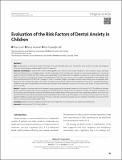- DSpace Home
- →
- Web Of Science
- →
- Web Of Science
- →
- View Item
JavaScript is disabled for your browser. Some features of this site may not work without it.
| dc.contributor.author | Uzel, İlhan
|
|
| dc.date.accessioned | 2024-04-29T07:54:06Z | |
| dc.date.available | 2024-04-29T07:54:06Z | |
| dc.date.issued | 2022 | |
| dc.identifier.issn | 2147-9445 | |
| dc.identifier.uri | http://hdl.handle.net/11547/11635 | |
| dc.description.abstract | im: Dental anxiety is described as state anxiety due to dental treatment procedures. The present study aimed to evaluate the etiological factors of dental anxiety in children aged 7-8 and 11-12 years old. Materials and Methods: A total of 370 children of both genders were enrolled in this study. The parents' socio-economic status, education levels and family income, oral hygiene habits, and the caries status of the children were recorded on a structured questionnaire. The dental anxiety of both the children and their mothers was evaluated by the administration of a questionnaire based on Corah's dental anxiety scale (DAS). The children's fear survey schedule-dental subscale (CFSS-DS) was also used to assess the dental anxiety levels of the children. Data were analyzed using the SPSS (SPSS Inc., Chicago, IL, USA) 19.0 software program. Descriptive statistics were used for socio-demographic data. Parametric and non-parametric tests were used to compare means/medians, whereas the chi-square test was used to compare proportions. Student's t-test and one-way ANOVA with Bonferroni correction were employed to compare the anxiety scale results. All significance levels were set at 0.05. Results: A negative correlation was found between the age groups and dental anxiety levels in the children (p=0.02). The difference between gender and dental anxiety was statistically significant (p=0.01). Boys were found to be more anxious than girls. The differences between the dental anxiety and the education levels of the mothers and the family income of the parents were not statistically significant (p>0.05). It was detected that the maternal dental anxiety level strongly affected the anxiety level of the children in the group of 7-8 years (p=0.01), while no significant difference was found in the group of 11-12 years (p>0.05). A positive correlation was found between the dental caries scores of the children and their dental anxiety level (p=0.01). Conclusion: Dental anxiety is multifactorial and is far more complex than can be explained by a single contributing factor. | tr_TR |
| dc.language.iso | en | tr_TR |
| dc.title | Evaluation of the Risk Factors of Dental Anxiety in Children | tr_TR |
| dc.type | Article | tr_TR |
Files in this item
This item appears in the following Collection(s)
-
Web Of Science [1145]
